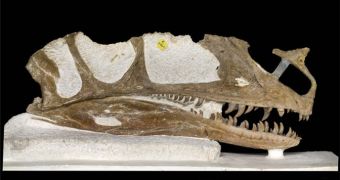Paleontologists have recently identified a new species of dinosaur that they believe is the oldest known ancestor of the mighty Tyrannosaurus Rex, one of the most fearsome predators to have ever lived. The 170-million-years-old beast was only 10 feet (about 3 meters) in length, and featured a tiny horn on its snout. It barely looked like its future successor, but experts are fairly convinced that the two animals are of the same lineage. T. Rex is one of the most renowned species of dinosaurs, having evolved into giant killing machines just before the giant lizards went extinct, some 65 million years ago.
The T. Rex predecessor has been named Proceratosaurus. “We can say conclusively it's the earliest representative of the line of evolution that led to Tyrannosaurus,” Natural History Museum of London expert Angela Milner explains. She was also a researcher involved in the new study, which was published in the latest issue of the respected Zoological Journal of the Linnean Society.
“The side of the skull is composed of a series of engineering struts, and they allow the skull to be much lighter and provide a lot more area for muscles that open and close the jaws. They can actually bulge through these windows,” the expert says of Proceratosaurus' skull. It was definitely different from the massive, thick skull that protected T. Rex's tiny brain, experts say. However, this “windowed” design allowed for both species to have extremely powerful bites, capable of shredding their prey to pieces.
The new skull was dug up from an archaeological site near Minchinhampton, in Gloucestershire, England. Finding the fossil, which is only about 11 inches (30 centimeters) long, comes on the heels of another recent discovery, which saw another T. Rex precursor being unearthed in northeast China. The animal lived some 125 million years ago, and is also believed to be part of the Tyrannosaurus family. “In other words, Tyrannosaurs for a long time were a group of quite small animals going back through time. And they only got suddenly very large right toward the end of the age of dinosaurs,” Milner adds.
The Proceratosaurus skull was originally described inaccurately in 1910, but it was only recently that modern, computed tomography (CT) imaging methods allowed for it to the classified correctly. Upon seeing the results of the scans, the researchers immediately observed the air spaces inside the skull, the banana-shaped teeth, and the large windows in the bones, all of these being a clear mark of Tyrannosaurs Rex and others in the species. “The Tyrannosaurs fed by a puncture-and-pull technique using the mouth to bite down on prey and just pull pieces off. Some other kinds of meat-eating dinosaurs had slicing teeth,” Milner concludes for LiveScience.

 14 DAY TRIAL //
14 DAY TRIAL //